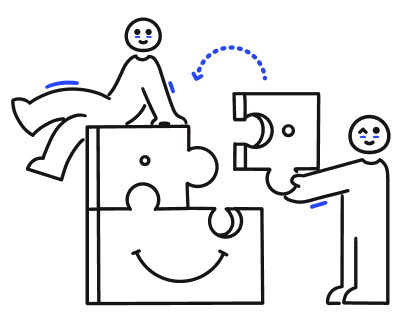Engaging employees and keeping them motivated is one of the biggest challenges managers face. That said, the ROI of motivating your team is worth the effort — it’s the fuel of performance and productivity and the secret behind a workforce that excels expectations.
According to Gallup, only 33% of U.S. employees (full and part-time) feel engaged at work, highlighting the significant opportunity for managers to improve their teams' motivation.
How can managers tap into employee motivation to boost performance? This article explores how managerial leadership can hugely influence motivation and practical ways for managers to inspire employees — with tried-and-true actionable steps to create a more engaged and productive team.
From flawed to flawless: 5 steps to leading distributed teams

What's in this article
Why employee motivation matters
Employee motivation influences many aspects of a business. Motivation is key to overall success, from productivity and retention to culture. By understanding the importance of motivation, managers can design the right strategies to enhance their team’s drive to perform.
The impact of motivation on productivity
The short and sweet is that employee motivation directly impacts productivity. If employees are motivated, they’re more focused, committed, and willing to go the extra mile, which ultimately leads to better work quality and output.
Also, a motivated team is more likely to meet deadlines, produce innovative ideas, and maintain high standards of work — all of which contribute significantly to the organization’s success. A motivated employee is an employee who cares.
Employee motivation and retention
If you’re an HR expert, you’ll love this: motivation also contributes to retention.
The higher the motivation, the lower the turnover. When employees feel valued and engaged, they’re much more likely to stay with the company, reducing recruitment and training costs.
By retaining motivated employees, valuable knowledge and skills remain within the organization. So continuity and stability can be considered as byproducts of motivation too.
The role of motivation in workplace culture
Enthusiasm and engagement spread throughout the team, creating an environment where collaboration and innovation thrive. Motivated teams are happy, united, and work in cohesion. support each other, share ideas, and contribute to a dynamic and positive work environment.
But motivation doesn’t come from thin air; it requires leadership to empower and inspire employees to unite and feel accountable for their success. Managers, the next section is for you.
4 ways to be a motivational manager
Motivating your team drives performance and fosters a positive work environment. As a manager, your role is to inspire employees to reach their full potential and remain engaged in their daily work.
No small feat, but here are four effective ways to embody a motivational manager.
#1. Be authentic and honest
Authenticity is key to great leadership. Managers who are genuine and transparent gain trust with their teams. Authenticity involves showing your true self, admitting when you don’t have all the answers, and being transparent about company developments.
Being honest about challenges and successes will create openness and mutual respect. This honesty creates a safe space for employees to be open and authentically themselves — which means they’ll come to you to find solutions rather than minimize problems out of fear of being judged.
#2. Provide constructive feedback
Constructive feedback helps employees understand their strengths and areas for improvement. Regularly providing feedback shows that a manager is invested in their growth and development and is here to support them.
Instead of focusing solely on what went wrong, highlight what was done well and offer practical advice on improving. This human approach boosts employee confidence, empowers them in their development, and motivates them to keep forging ahead — even when mistakes happen.
Don’t miss the window: Effective feedback should be specific, actionable, and delivered promptly. Continuous feedback loops ensure that feedback is given in real time when it’s most relevant.
#3. Set clear and inspiring goals
When employees understand what they’re working towards and see the bigger picture, they’re more motivated to achieve their targets. By setting clearly defined goals, a manager gives the team direction and purpose.
The best way to set goals is through collaboration. In other words, sit down with your team to co-create realistic goals. This guarantees the team
Remember the SMART method: Motivating goals are specific, measurable, achievable, relevant, and time-bound. Click here to brush up on your goal-setting strategies.
#4. Embrace employee ideas
By encouraging employees and valuing their input, managers help their teams tap into innovative solutions and a sense of ownership.
How can you create an environment where employees feel comfortable sharing their ideas? Small tokens of appreciation, like recognizing and implementing employee suggestions, can demonstrate that everyone’s contributions have an impact.
Here’s a tip: Create an “Idea of the month” program where employees can pitch their ideas casually, and the best idea wins a small reward or recognition at a company meeting.
How to motivate your employees: 6 managerial strategies
So, what managerial methods will help inspire and motivate your employees? Here are 6 practical strategies to enhance motivation in your team.
#1. Recognize and reward efforts
Employee recognition is a powerful motivator—don’t underestimate it! Whether it’s a simple thank-you note, a shout-out during meetings, or acknowledging efforts, it boosts morale and motivation all around. Employee incentives like rewards or bonuses provide the same effect.
Managers and HR leaders should join forces to create a culture of recognition where achievements, both big and small, are celebrated. Implementing a structured recognition program that includes peer-to-peer recognition, manager recognition, and company-wide acknowledgments will ensure a system that doesn’t let appreciation fall by the wayside.
Thinking outside the box tip: Recognition walls are so yesterday… Let’s make peer-to-peer praise more personal! Engagement tools with automated prompts help colleagues get creative with their shoutouts — and can tailor them aligned to your company’s values, too.
#2. Create a positive and supportive work environment
A positive work environment reduces stress and fosters a sense of belonging, essential for sustained motivation. A supportive and inclusive workplace where employees feel safe and valued enhances motivation. This includes promoting diversity, equity, and inclusion and ensuring a comfortable and engaging physical workspace.
Encourage open communication between employees to help foster a sense of community and create opportunities for social interaction and team-building activities, such as after—work drinks or group lunches.
Fun fact: Happy environments create dedicated employees. Indeed, 87% of executives believe that happiness at work is a definite competitive advantage — but only 20% of organizations actually have employee well-being strategies in place.
#3. Offer growth and development opportunities
Providing opportunities for professional development shows employees you’re invested in their future. Training programs, workshops, and career advancement paths can all significantly enhance motivation. Regularly discuss career aspirations during one-on-one meetings and provide guidance on how they can achieve their career goals within the company. And keep encouraging employees to set personal development goals and support them in pursuing relevant training and certifications.
Thinking outside the box tip: Offer a “learning budget” for each employee to use on courses, books, or conferences of their choice. This empowers them to take charge and feel proud of their growth.
#4. Promoting work-life balance
Work-life balance — we talk about this a lot. And it’s more than just a buzzword! Managers encouraging teams to maintain a healthy work-life balance protect employees from burnout or job-related resentment.
Flexible working hours, remote work options, and wellness programs are effective strategies to help attain this balance. Implementing policies, such as flexible schedules and remote work arrangements, can also help employees manage their work and personal responsibilities more effectively.
Fun fact: Money doesn’t always talk. In fact, employees value work-life balance just as much as they do their pay — it’s a tie at 93.7% and 93.8%, respectively!
#5. Lean on active listening
Active listening shows employees that their opinions matter. But what is it exactly? Unlike passive listening, active listening involves giving full attention, acknowledging their ideas, and responding thoughtfully. This practice builds stronger relationships and enhances employee motivation.
Here’s a trick: Focus on the person speaking without interrupting during meetings and one-on-one conversations. Paraphrase their points to show you understand, and ask follow-up questions to delve deeper into their thoughts.
Thinking outside the box tip: Hold monthly “listening sessions” where employees can share their thoughts and ideas in a relaxed, open forum, with no agenda other than to listen.
#6. Prioritize trust building
Trust is the foundation of any strong relationship. Managers build trust by being consistent, reliable, and transparent with their employees. Keeping promises, admitting mistakes, and showing empathy toward employees’ concerns all foster a trusting dynamic.
Trust also involves giving employees the autonomy to make decisions and take ownership of their work. When employees feel trusted, they’re motivated to take initiative and perform at their best. So try loosening the reins more — and see if something positive comes from that.
Fun fact: When the three main pillars of leadership are present — clear communication, future-leading, and supporting through change — 95% of employees fully trust their leaders.
Boosting employee motivation examples
When it comes to motivation, sometimes it’s all about finding the right words. Positive reinforcement and expressions of appreciation can really go a long way.
Here are some key phrases you can use to boost your troops.
Positive reinforcement examples
Using positive reinforcement helps employees feel appreciated and acknowledged for their hard work. Put your own spin on these:
- “I appreciate your hard work on this project. Your dedication really shows.”
- “Your innovative solution to this problem has made a big difference. Great job!”
- “You’ve done an excellent job with this task. Keep up the great work!”
- “Your positive attitude and hard work are truly inspiring. Thank you for being you!”
- “Your contributions to the team are invaluable. We couldn't have done it without you.”
Phrases to show appreciation and recognition
Expressing gratitude and recognizing achievements can significantly enhance an employee's sense of worth and motivation. Try phrases along the lines of:
- “Thank you for going above and beyond to meet our deadline.”
- “Your attention to detail is invaluable to our success.”
- “I’m grateful for your consistent hard work and dedication. It doesn’t go unnoticed.”
- “Your creativity and innovative ideas have really helped our team succeed.”
- “I appreciate your willingness to take on new challenges and learn new skills.”The relationship between employee engagement and employee motivation
Employee engagement and motivation are closely linked and hugely influence each other. When employees are engaged, they become more motivated to do good work, and when they’re motivated, they become more engaged in what they do.
Engagement is all about an employee's emotional connection with the company and its goals. When someone is engaged, they're passionate about their job. They feel connected to their team and believe their work really matters. This sense of purpose and belonging naturally boosts motivation, making employees want to put in their best effort.
Motivation, on the other hand, is what drives employees to take action and aim for excellence. Motivated employees are keen to perform well, meet their targets, and help the company succeed. This drive often leads to higher engagement, as motivated employees are likelier to pour their energy and enthusiasm into their tasks.
By fostering engagement and motivation, managers can create a positive cycle reinforcing the other. Engaged employees become more motivated, and motivated employees become more engaged. It’s a win-win.
Things managers do that kill motivation
Managers play a critical role in shaping employee motivation. However, certain behaviors can inadvertently diminish enthusiasm and engagement—and we don’t want that! Below are common managerial practices that can negatively impact motivation and actionable tips to foster a more positive (and motivating) environment instead.
Micromanaging
When managers hover over employees and don’t give them the space to work autonomously, micromanaging stifles creativity and independence. Micromanagers, or helicopter managers, signal to their employees that they lack trust in their abilities, leading to frustration and disengagement.
Try this instead: Give employees the autonomy to make decisions and take ownership of their projects. For example, if an employee works on a marketing campaign, allow them to develop and implement their ideas, providing guidance and support only when necessary.
Focusing on mistakes
Constantly highlighting errors rather than successes can demoralize employees. Yes, mistakes need to be corrected, but everyone makes them occasionally. Focus on constructive feedback and solutions rather than blame. A balanced approach that recognizes both achievements and areas for improvement keeps motivation leveled.
Try this instead: When an employee makes a mistake, address it privately and constructively. For instance, if an employee misses a deadline, discuss what went wrong and how it can be avoided. Also, make it a habit to publicly acknowledge their successes to maintain a positive balance.
Dismissing ideas
Ignoring or dismissing employee suggestions can make them feel undervalued. Encouraging and considering their ideas shows respect and can lead to innovative solutions. Create a culture where all ideas are welcomed and considered, and implement a structured process for evaluating and acting on employee suggestions to demonstrate that their input is valued, impactful, and not biased.
Try this instead: Host regular brainstorming sessions to welcome and consider all ideas. For example, if an employee suggests a new process for handling customer complaints, evaluate it seriously and implement it if feasible, showing that their input is valued.
Not keeping promises to employees
Failing to follow through on commitments as a manager can erode trust and motivation from employees. Once trust is gone, it’s hard to regain it. Consistency in actions and promises is crucial for maintaining employee morale.
Try this instead: Always honor your commitments or communicate openly if circumstances change. For example, if you promise an employee a promotion opportunity, keep them updated on the timeline and any necessary steps they need to take to achieve it.
Holding unnecessary meetings
We’ve all been there — meetings that lack purpose or clear outcomes waste time and can frustrate employees. Managers should ensure meetings are productive and necessary to keep teams engaged.
Try this instead: Set clear meeting agendas and ensure they have specific objectives. For example, before a team meeting, outline the key points to be discussed and the desired outcomes, and stick to the agenda to respect everyone's time
Measuring employee success wrong
Using inappropriate metrics to evaluate performance can be demotivating. Imagine working really hard in your field of expertise but being graded on something completely outside your remit. Managers should focus on relevant, fair, achievable performance indicators aligning with individual and team goals to ensure comprehensive and fair evaluations.
Try this instead: Tailor performance metrics to reflect each employee's contributions. For example, if an employee's role involves customer service, measure their success based on customer satisfaction ratings rather than unrelated sales targets.
Unrealistic deadlines
Unattainable deadlines can cause stress and burnout. They make employees think: What’s the point of trying if I’m set up to fail? Managers should ensure realistic timelines and allow for high-quality work without overburdening employees. Flexibility and understanding in deadline management can also help prevent burnout and maintain motivation.
Try this instead: Collaborate with your team to set realistic deadlines. For example, if a project typically takes two weeks to complete, avoid compressing the timeline to one week without considering additional resources or support.
Favoritism
We’re all prone to bias—the key is to keep that in check. Showing preferential treatment to certain employees, even if subconsciously, can create resentment and reduce overall team motivation. Managers need to treat all team members fairly and recognize their unique contributions.
Try this instead: Ensure recognition and opportunities are based on merit and performance. For example, implement a transparent process for awarding promotions or bonuses that are based on clear, measurable criteria accessible to all employees
Boosting motivation through employee engagement software
Keeping employees motivated is an ongoing effort that needs dedication from managers. Creating a positive work environment, recognizing achievements, and keeping communication lines open can boost employee motivation and engagement.
Motivating employees effectively means managers must consistently put in the effort and engage genuinely. Understanding how important motivation is and using strategies that create a positive, supportive workplace can really enhance productivity, retention, and overall workplace culture. It's crucial to avoid the common managerial pitfalls that kill motivation and instead take a proactive, respectful approach.
For more tips and strategies on motivating your team and boosting workplace motivation, explore our additional resources and discover how you can lead your team to success!
Equip HR and managers with tools to engage, recognize, and drive performance.




